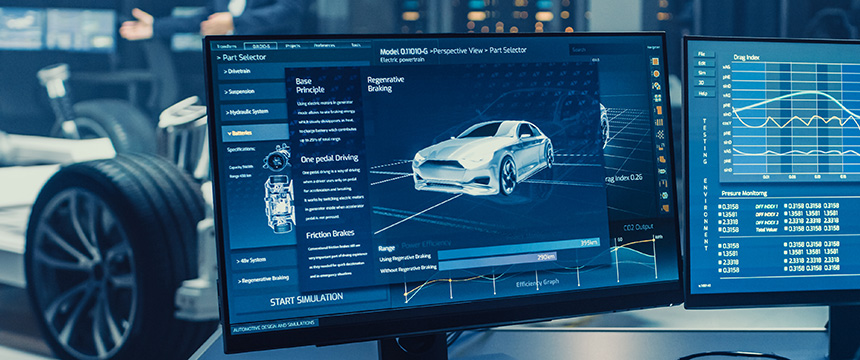
Automobiles may be the most complex, essential and widely used consumer products in the world and every year they incorporate increasingly advanced technology into nearly every component and function. The advancing technology, as well as increased or changing regulatory scrutiny, raises new legal challenges for automakers and their component suppliers, particularly with respect to product liability. In this article, we address key product liability challenges every automotive company must prepare for in this fast-changing industry.
Marketing Vehicles with Autonomous Capabilities
The advent of vehicle autonomy arrives against a broader backdrop of U.S. tort litigation increasingly featuring class actions, multi-district litigation, and other types of lawsuits combining more than one plaintiff. Recently, consumer class action lawsuits have started focusing on alleged misrepresentations by automotive manufacturers regarding driver-assistance technology. Plaintiffs also are bringing statutory claims under unfair competition and false advertising laws, along with common law claims like fraud and negligent misrepresentation, in a variety of jurisdictions across the country based on claims made about autonomous capabilities.
Given the growing number of cases, automotive companies should review any marketing materials or representations describing the autonomous features of their vehicles’ functions and consider how they can prove the accuracy of any representations and modify or delete language a consumer (or juror) could consider misleading. Suppliers who provide components of self-driving systems (including software) should not only carefully word and document any representations made to partners in the supply chain about the capabilities of their technology, but also review how their customers describe the features and performance attributes that rely upon the supplier’s component or subassembly.
Liability for accidents involving fully or partially autonomous vehicles
A longstanding legal issue regarding driver-assisted technology is who is liable in an accident where driver-assisted technology was being used in the vehicle: the driver, the component manufacturer, the car manufacturer, or all or none of the above?
The answer in lawsuits to date – pre-fully autonomous vehicles – has been the driver. Tomorrow? It is much less clear, and the closer vehicles get to full autonomy, the more exposure manufacturers and suppliers will face. As just one example, California allows manufacturers to test near-to-fully autonomous vehicles on public roads, but requires at least $5 million in insurance and the ability to satisfy judgments for damages arising from resulting accidents. Cal. Veh. Code § 38750. Even today, when nearly all driving is being done under direct human control, most crashes involving a vehicle with sophisticated autonomous capability require scrutiny of the vehicle system’s potential role in the crash. As various types of autonomous technology become ubiquitous in vehicles, it will not be long before such technology is the subject of product liability design defect claims alleging a “reasonable alternative design” existed that could have prevented the accident, along with claims alleging manufacturing defects in the autonomous system itself or failures to warn of attendant risks.1
Automotive companies must take steps at every stage of the manufacturing process to manage the risk of liability. Detailed indemnification provisions are essential and warnings included with the vehicle specific to self-driving capability and its limitations should be well-drafted and prominently featured, particularly in the interim period before universal adoption of fully autonomous vehicles.
New Product Liability Risk from Proliferating EVs
By one current estimate, 1% of the approximately 250 million vehicles currently in use in the U.S. are electric vehicles (EVs), but that number jumps to 30% by 2030. The proliferation of EV batteries has already led to lawsuits against various manufacturers concerning a broad variety of claims such as the alleged loss of vehicle range or alleged risk of combustion and fire. EV technology is in a state of rapid development, with regulatory pressure creating incentives to accelerate EV development and production still more. With faster and broader development and production comes greater risk. EV chargers also create a new frontier of product-related risk, as various charging products are used both at home and at charging stations across the country. Who owns those charging stations, and who is responsible for any resulting issues, will be another emerging facet of product liability litigation in this area.
Managing Cybersecurity and Data Privacy Safety Risks
The state of the art technology that today’s vehicles incorporate bring more opportunity for cybersecurity threats and breaches, along with issues involving data privacy. Every industry is facing constant, and constantly evolving, security and liability threats in the cyber and data realms.
In Flynn v. FCA US LLC, 39 F.4th 946 (7th Cir. 2022), an alleged security vulnerability in the “infotainment” system in certain Chrysler vehicles led first to a recall and then to a consumer class action in Illinois.2 Plaintiffs alleged they paid more for their vehicles than they would have if they had known about the potential vulnerability. While the court ultimately found that the plaintiffs failed to provide evidence support their claims (a decision affirmed by the Seventh Circuit Court of Appeals), this case demonstrates the serious issues and potential liability surrounding cybersecurity in today’s vehicles. Auto companies should proactively and routinely update software included with the vehicle as potential weaknesses are discovered, and thoroughly document both design and any remedial steps taken to address risks once they are discovered.
All supply chain participants must also be aware of and following legal developments impacting data collection and privacy. Every year the technology present in vehicles becomes more sophisticated, capable of collecting, storing and transmitting new types and higher quantities of data. Autonomous vehicles accelerate this trend, as they require even more sensors and types of data to operate. For example, California has had its Consumer Privacy Act in place since 2018,3 but voters approved additional privacy protections that took effect on January 1, 2023, including the right to correct inaccurate personal information a business collects, and to limit use and disclosure of certain other information. Other states, including Colorado, are working on new regulations in this area as well. Data privacy policies must be routinely audited to ensure they are compliant and correctly addressing the current legal requirements in markets where vehicles are sold. Companies also should document all justifications existing for collected data, for example, emphasizing that certain data collected about the car’s occupants is for a specified safety-related purpose.
Product liability risks caused by using substitute components as a result of supply chain disruption
Recent supply chain disruptions have led to widespread litigation, mainly focused on contract-based disputes about terms, warranties, force majeure and similar issues. While those most immediate disputes likely will continue, auto companies may soon find themselves defending plaintiffs’ claims stemming from how those companies addressed shortages of critical components such as resin, aluminum, steel, and, perhaps most importantly, semiconductor chips. If product failures occur (including software), one can be confident that the class action plaintiffs’ bar will investigate and potentially allege that a vehicle had a defect or failed to comply with standards because the manufacturer made substitutions without the time or ability to properly vet and verify new suppliers or the components they supplied.
Companies should have a response plan and a leader with decision-making authority in place to quickly address these supply chain disruption related issues as they arise. Suppliers should ensure that they have thoroughly documented both the requirements and specifications provided by OEMs, as well as any requirements and specifications that were provided to sub-suppliers or others in the supply chain. Suppliers also should maintain a living database of all representations and certifications provided by sub-suppliers in case the validity of compliance is challenged.
Conclusion
In the face of multifaceted and expanding product liability risk, the most essential step that any manufacturer or supplier can take is to be prepared. Make sure to thoroughly document new processes that have been implemented to comply with new regulations. Conduct regular audits of your supplier contracts and supply chain partners, and consider increasing the frequency of such audits (and the breadth of supplier due diligence) when new suppliers have been brought into the company’s chain for new technology or materials, or due to shortages, near-shoring or re-shoring. And finally, closely scrutinize the company’s policies and practices regarding data collection and security, as well as marketing and other representations particularly addressing self-driving capability and environmental promises.
1 At least one court held that driver assistance software or “programmable logic” is a “product” within the meaning of classic product liability claims because it was an essential part of an autonomous assembly line. See Holbrook v. Prodomax Automation Ltd., No. 1:17-CV-219, 2021 WL 4260622, at *5 (W.D. Mich. Sept. 20, 2021).
2 Id. at 949.
3 Cal. Civil Code § 1798.100.
